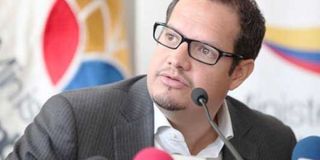Ecuador ready for foreign investment: mining minister

What you need to know:
Titled ‘Ecuador - From Promise to Reality,’ Córdova’s presentation was an overview of the changes the government enabled to create an environment that more attractive to mineral investors.
Toronto, Canada /AFP/. Ecuador’s minister of mining Javier Felipe Córdova was surrounded by enthusiastic mining executives after his presentation at the 2017 Mines and Money Americas conference in Toronto, Canada.
Titled ‘Ecuador - From Promise to Reality,’ Córdova’s presentation was an overview of the changes the government enabled to create an environment that more attractive to mineral investors. “We looked at how we could make Ecuador a mining country with many opportunities and create the right scenario for investments,” said Cordova. The country is sitting on significant deposits of gold and copper.
These changes started by addressing the 70 percent windfall tax that was unfavourable to investors. The government removed the windfall tax and did a benchmark analysis of the tax burden in the region. “We understood that our tax burden was much higher than other countries in the region compared to Peru, Chile, Argentina, Brazil, Mexico and Columbia. Once we had the analysis, we created tax incentives to lower our burden.” The government also worked with Mackenzie Investments crafting tax incentives like the fiscal stability agreement, reimbursement of VAT and allowing companies to recover their investments before taxes are applied.
That shift has brought their tax burden in line with the rest of the region and given them some advantages. Cordova said that since Ecuador is still a mostly underdeveloped country with only 10 to 15 percent explored, there is opportunity for new projects. Another advantage is the low operating costs compared to the rest of the region with infrastructure costs sitting at 40 percent less.
“This is due to very high investments in hydroelectric projects over the last 10 years,” he says. “The labour costs, fuel and transportation costs are lower, and we have spent $40 billion dollars since 2007 in strategic sectors like electricity, new ports, highways and airport infrastructure.”
While Ecuador has had small-scale mining for a century, exporting $300-400 million (US) in gold per year, this push into large-scale mining is expecting to bring the government $4.6 billion (US) of direct foreign investment by 2021, based off production from the first generation of mines: Mirador, Frutadel Norte and Rio Blanco. It is also estimated that 25,000 new jobs will be created in the next four years. Cordova says that when Ecuador opened for concessions, there was a deluge of bids. They expected 300 but have received more than 800. They’ve granted 250 so far this year with investment commitments of $500 million (US) over the next four years.
“We feel we’re in a fairly good place but I think we can make things even better,” said Cordova. “We have seen huge developments from the industry towards Ecuador in the last three years. The people and investors are looking at Ecuador with a lot of potential and that is encouragement for us.”



